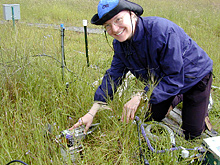|
Introduction
 The area now included within the Jasper Ridge Biological Preserve has been used for scientific studies since the opening of
Stanford University. The Preserve is widely recognized as the site of discoveries that have been important both to the scientific
community and to society. For example, Professor Paul Ehrlich's discoveries about Bay checkerspot butterflies demonstrated the
unique value of long-term research in ecology, and led to federal programs to fund such studies. The importance of long-term
research and monitoring is now widely accepted.
The area now included within the Jasper Ridge Biological Preserve has been used for scientific studies since the opening of
Stanford University. The Preserve is widely recognized as the site of discoveries that have been important both to the scientific
community and to society. For example, Professor Paul Ehrlich's discoveries about Bay checkerspot butterflies demonstrated the
unique value of long-term research in ecology, and led to federal programs to fund such studies. The importance of long-term
research and monitoring is now widely accepted.
A number of scientific publications from JRBP research have discovered ecological patterns so significant that they fostered hundreds of related studies. Jasper Ridge also contributes broadly in that it is open to any qualified investigator who proposes studies that are consistent with the Preserve's mission of research, education, and long-term resource protection. In total, 165 dissertations and theses have involved research at JRBP, and since 1965, 325 publications have reported research at JRBP. Perhaps most importantly, Jasper Ridge demonstrates the value that a university has placed on protecting and managing an area for research and education. Current Research
 In recent years, the number of research projects has averaged about 60 per year, involving roughly the same number
of investigators. About half of these investigators are faculty or senior scientists, and half are graduate
students and postdoctoral fellows. Undergraduates conduct research as part of field classes, honors theses, and
summer internships. About two thirds of the investigators are from Stanford, and the remaining third typically
represent a dozen other institutions.
In recent years, the number of research projects has averaged about 60 per year, involving roughly the same number
of investigators. About half of these investigators are faculty or senior scientists, and half are graduate
students and postdoctoral fellows. Undergraduates conduct research as part of field classes, honors theses, and
summer internships. About two thirds of the investigators are from Stanford, and the remaining third typically
represent a dozen other institutions.
Stanford investigators come from three Schools (Humanities and Sciences, Earth Sciences, and Engineering) and from six different departments (including Biological Sciences, Archaeology, Geology, and Geophysics) or centers. The Carnegie Institution of Washington's departments of Global Ecology and Plant Biology, which are located on the Stanford campus, also have major research programs at JRBP. Search Research Projects Database Research Themes
Although the departmental affiliations of investigators suggest the breadth of research at JRBP, individual studies typically bridge multiple disciplines and cluster along four themes.
Environmental and biotic change. Many factors make JRBP both vulnerable to environmental impacts and also well suited to studying those impacts. Studies in this area focus on fundamental questions and have chosen ecosystems and species at JRBP as good test cases for providing general insights. There are studies of invasions by exotic species such as yellow starthistle, Argentine ants, and Chinese mitten crabs; and studies of shrub distributional patterns that may be altered by changes in climate. A large study, involving roughly a third of all researchers, examines the response of annual grassland to experimentally applied changes in atmospheric carbon dioxide concentration, air temperature, precipitation, and nitrogen inputs from atmospheric pollutants.  Structure of ecological communities.
Structure of ecological communities.The high diversity of soil types, ecosystems, and species at JRBP provides many opportunities for studying fundamental properties of natural ecosystems, which may help us understand what makes ecosystems sustainable. Studies at JRBP examine the relationship among habitat type, plant diversity, and physiological traits; changes in animal activity across seasons; effects on vegetation diversity due to natural disturbances such gopher tunneling; and differences in plant adaptations across transitions in soil chemistry resulting from altered topography or bedrock material. Many of these studies incorporate JRBP as either one of multiple field sites, or as a reference site for comparison with more disrupted ecosystems elsewhere. Geology and geophysics. Because it overlaps the San Andreas fault zone, JRBP is well suited to studies of earthquakes and other geophysical processes associated with the boundaries of tectonic plates. Current research includes very sensitive seismic monitoring and a search for earthquake predictors, such as alterations in the earth's electromagnetic field. Direct human influences. JRBP has been directly affected by human activities since prehistoric occupation more than two thousand years ago, and some areas were significantly altered during the past two centuries by grazing, logging, settlement, dam construction, and recreation. Current studies examine settlements and the use of native plants during the prehistoric period; effects of changes in the frequency of wildfires; and hydrologic changes and carbon storage associated with sedimentation in Searsville Lake. |
|||||||||||||||||||||||||||||||||||||||||||||||||||||||||||||||||||||||||||||||||||||||||||||||||||||||||||||||||||||||||||||||||||
| Terms of Use | Webmaster | © 1998 - 2015 Jasper Ridge Biological Preserve of Stanford University jrbp.stanford.edu | |